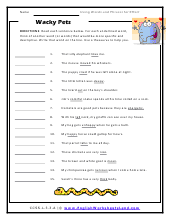Words and Phrases for Effect Worksheets:
Spooky Story Night – Help Charlie the Cat's story by making it more meaningful.
Wacky Pets – Make the story about these wacky pets more descriptive by changing out some words.
The Sandwich Board – Pop Mr. Meyers sign pop with emotion.
Choosing Words for Effect – Find all of the words in the letter matrix.
Mr. Moody – Mr. Moody really lives up to his name.
Degrees of Meaning – Next to each word, write a word that conveys the same general idea, but to a greater intensity.
Conveying Story Mood with Words – Read each passage below. Then decide which word in the chart best describes the mood of the story.
Building Tension with Words and Phrases – Read the passage. Underline the words, phrases and specific details that you think help to build tension in the story.
Choosing Strong Verbs – Cross out the weak verb. Choose a stronger, more descriptive verb to replace it and write it on the line.
Using Precise Verbs to Paint a Moving Picture – Cross out any verbs that could be stronger. Then rewrite the paragraph below, replacing them with more descriptive verbs.
The Talent Show – Mr. Rogers is acting as Master of Ceremonies at the school talent show, and he's practicing how he plans to introduce each act.
Campfire Stories – Kenny and his friends are telling spooky stories around the campfire. Choose the best opening line for each boy's story.
What do you know about Mole? – Read the passage below. Then answer the questions about the effect conveyed by the words and phrases.
Be My Valentine – Help Ryan show his friends how much he cares about them by rewriting his valentines using strong, descriptive nouns and verbs, sensory details, figurative language, or whatever else you can come up with to grab his valentines' attentions!
Uses Words and Phrases to Describe Character – Read each sentence below. What does the sentence tell you about the character?
Get FREE English Worksheets In Your Email

